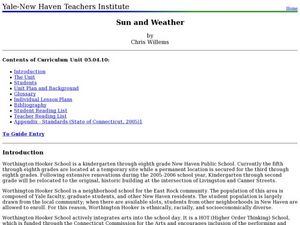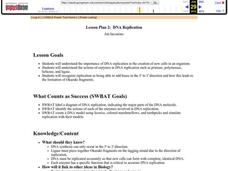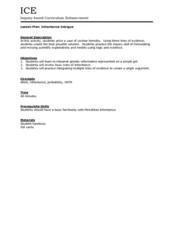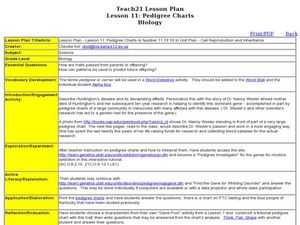Curated OER
Pesticide Watch Card
Young scholars examine human health by identifying dangerous pesticides. In this agriculture lesson, students research the food production system in the United States and discuss dangers such as pesticides, chemicals and insecticides...
Curated OER
Mutations and Cancer
High schoolers study how cancer cells mutate and affect cell division. In this investigative lesson students view a PowerPoint presentation learn the seven warning signs of cancer.
Curated OER
Managing Wildlife
Students discuss the current conditions of wildlife in New England. Students explore how animals are tracked and how their population is managed.
Curated OER
Sun and Weather
How is the Earth's weather created? Middle schoolers will explain how the Sun's energy is transformed into different forms. They will perform mathematical calculations of volume, mass, and temperature. They they will explain the...
Curated OER
Spring
Students examine lichens in an outside field trip. Students explore the diversity of this organism and ask questions about them.
Curated OER
Microarrays: Chipping Away at the Mysteries of Science and Medicine
Students research microarrays on the internet in cooperative groups. Students write an essay describing the use of microarrays in environmental research and in medicine.
Curated OER
Biotechnology Projects and Writing Assignments
High schoolers research a subject about biotechnology and do a project or a writing assignment on it. They can pick from a possible eighteen different projects and five different writing projects.
Curated OER
DNA Fingerprinting: You Be the Judge!
Students explore DNA fingerprinting. Students discover how DNA fingerprinting is done and judge the validity. They evaluate the use of certain prints in courts and address the ethics of establishing a national database of fingerprpints.
Curated OER
DNA Replication
Students create a model of DNA and simulate replication with their models in an activity that uses licorice, colored marshmallows, and toothpicks. Students also label a diagram of replication and indicate major parts of the DNA molecule.
Curated OER
Managing Wildlife
High schoolers explore the relationship between wildlife and humans in northern New England. They also brainstorm ideas on why they think some species are greater in population than others in a given area.
Curated OER
Connecticut Wildlife: Biodiversity and Conservation Status of Our Vertebrate Populations
Students explore the different types of vertebrates found in their area. In this environmental science activity, students perform a case study on the Common Raven. They analyze data collected from research and create charts and graphs.
Curated OER
Macro-DNA: Doing DNA Fingerprinting
Students explore gel electrophoresis using paper models. They model DNA sequences and shade the boxes on their Gel Electrophoresis Sheet which represent the individual fragments.
Curated OER
It's Alive! Using Microorganisms in Cooking
Students create a KWL chart about food. In this chemistry activity, students differentiate physical and chemical changes. They explain how microorganisms are used in food preparation.
Curated OER
Drosophila Melanogaster
Students cross wild type flies and mutants, both purchased from a biological supply house (Carolina Biological Supply or Wards, for example) in groups from instructional activity one.
Curated OER
How Do Organisms Reproduce
Middle schoolers examine the difference between mitosis and meiosis, and describe the steps involved in meiosis and the significance of each step. They create a diploid nucleus containing two pairs of chromosomes using clay.
Curated OER
Plant Structure and Growth
This plant structure and function PowerPoint addresses the main organs and the factors that affect its development as well as going into detail about the specializations at a cellular level. The cell functions and system adaptations...
Curated OER
The Selection and Variation in the Egyptian Origami Bird
Students participate in a contrived natural selection simulation in which they build and modify simple paper airplanes. They study divergent and convergent evolution and how it is isolated in sub-populations.
Curated OER
Sea Urchin Embryology
Students explore the process of evolution. They examine examples of how homeotic genes may work and obtain gametes. Using a microscope, students observe the fertilization of sea urchins. They video tape the process and write a...
Curated OER
DNA Detectives
Fifth graders define dominant and recessive genes and that they have DNA from their mother and father. In this inherited traits lesson, 5th graders complete a punnet square based on their parents traits. Students decorate their Punnet...
Curated OER
Wetland Plant Detectives
Sixth graders identify plants in the wetlands. In this plant detectives lesson, 6th graders complete a scavenger hunt on a local reserve, record observations, and respond in their journals.
Curated OER
Inheritance Intrigue
Pupils slve a case of unclear heredity using three lines of evidence and knowledge gained from the lesson in this biology lesson about Mendelian inheritance. The lesson includes handouts and a question sheet for final, individual...
Curated OER
Characteristics of Living Things
Seventh graders identify the characteristics of living and non-living things. In this biology lesson, 7th graders define vocabulary words as they go through the lesson. They answer a crossword puzzle after class discussion.
Curated OER
Pedigree Charts
Students explain how offspring inherit traits from their parents. In this biology instructional activity, students investigate the genes for nicotine addiction using an interactive website. They construct a fictional pedigree using their...
Curated OER
High Tech Food
Learners view videos, read, and fill in charts about agriculture production. In this agriculture lesson plan, students complete these agriculture activities and explore careers in agriculture.

























